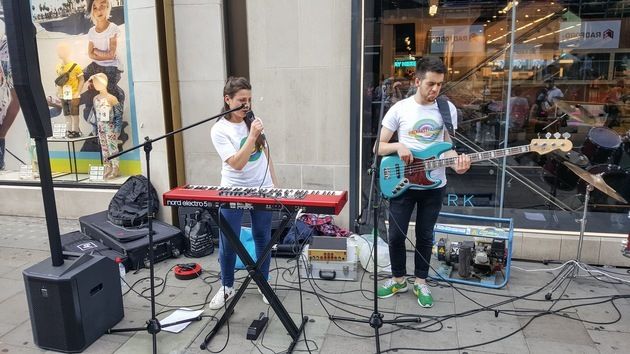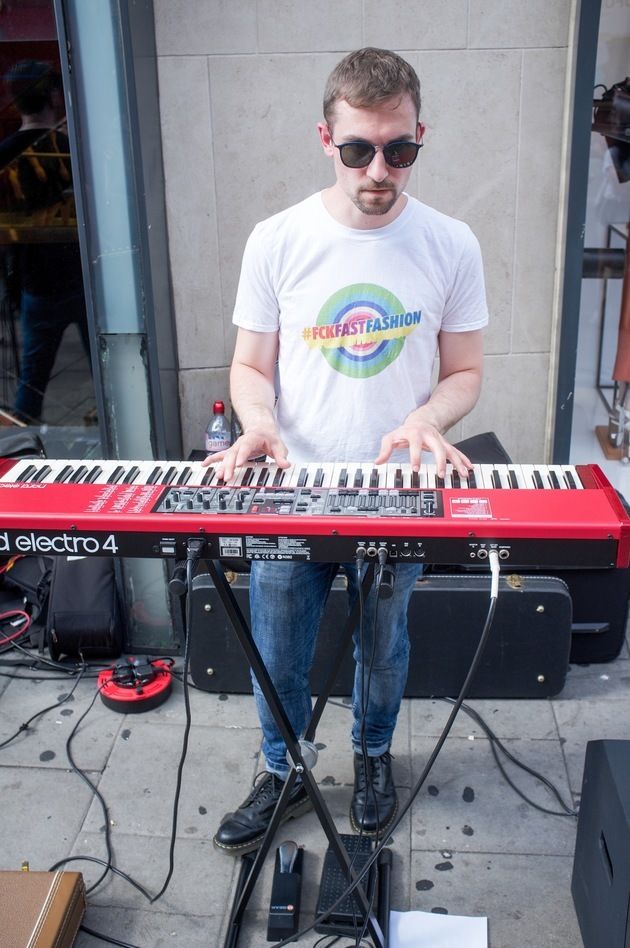On June 3rd, The Tomicks played an anti fast fashion gig outside the Primark by Tottenham Court Road tube station on Oxford Street in London. The set list included “Candlelight” and “Big Mistake”, alongside covers of protest anthems from the late 1960s and early 1970s such as “Come Together”, “Have You Ever Seen The Rain?” and “Imagine”. This protest was called #FckFastFashion and is just the beginning of a series of similar peaceful demonstrations against fast fashion retailers whose ethos undermines our beautiful planet and its people. Why was the decision made to take to the streets of London to rally against this apparently unstoppable fashion phenomenon? It comes down to three key questions.

In the five years since the Rana Plaza building collapsed in Bangladesh killing more than 1,000 and injuring over 2,000 clothing factory workers, have fast fashion retailers actually materially improved conditions for their workers, eliminated child labour and ensured that everyone involved in their supply chain is paid a fair living wage? According to recent statistics by the International Labour Organisation, over 218 million children are working and 73 million of them are working in an environment that “directly endangers their health, safety, and moral development.” It is becoming more and more prevalent the fashion manufacturers and brands might have a lengthy section on child labour within their supplier code of conduct but then fail to take steps to ensure these policies are subsequently put into practice. 426 fashion industry workers died in “workplace incidents” in 2017 alone, with workers’ rights remaining extremely compromised. To form any kind of workers union and protest against unfair treatment can sometimes mean risking death, as demonstrated by the murder of a union leader in Bangladesh earlier this year and the killing of activists by Cambodian police officers. Indeed, the fashion industry is still rife with the abuse of women, unpaid wages and toxic chemicals. The gender pay gap has become a focus for Hollywood but in developing countries where the fashion industry can often have predominantly female workforces, misogyny and sexism is shamefully prevalent, with many women underpaid, overworked, bullied and harassed. Facts and figures on sustainability progress in the fashion industry invariably focus on the environmental impact of textile production and often obscure equally important social issues that the industry still needs to sort out. As the founder of Fashion Revolution, Carry Somers puts it, “Five years on from Rana Plaza, both people and the environment still suffer as a result of the way fashion is made, sourced and consumed. Most companies are still operating in broadly the same way that enabled the Rana Plaza disaster to occur, relying on auditing for basic legal compliance. Fashion brands had repeatedly audited the factories in the Rana Plaza complex, but the risks went either undetected or ignored.”

What do fast fashion retailers think about the environmental impact of the attitude of treating clothing as quickly disposable, which they clearly promote through their pricing structure and collection release cycles, which has resulted in the industry becoming the world’s second most polluting, with billions of tonnes of discarded garments in landfill? There might have been some level of progress but the fact remains that such is the level of waste being produced by fast fashion that we may never reach the utopia of a “quality quantity equilibrium”. It is also becoming increasingly likely that by as early as 2030 natural resources will have become so jeopardised that any move towards a more sustainable future will be near impossible. Millennials are tiring of the ethos of brands like H&M and Forever 21 and that thrift shops are thriving but they then highlight that this is partly due to the success of rivals such as ASOS and Missguided whose supply chain times are as low as one week. This does not point to a much needed change of attitude to clothing consumption. The pressure to constantly be seen in something new is as pervasive and entrenched in Western society as it ever was, the grim reality being that the gross exploitation of the world and its resources means that no Instagram addicted adolescent need suffer the unthinkable “FOMO” that would be induced as a result of wearing something twice due to the fact fast fashion is so cheap. This mass produced clothing is of such decreased quality it will invariably inherently have a shorter life cycle and, therefore, will not be recycled but end up in landfill.

Are consumers any better off with fast fashion or would they, in fact, be wearing higher quality clothing, saving money in cost per wear, reducing their impact on the environment and supporting fairly paid and ethically treated workers in the fashion industry by opting to #FckFastFashion?

The Tomicks’ #FckFastFashion protest concerts will continue this Thursday June 21st in London outside Topman by Oxford Circus tube station from 7pm.
